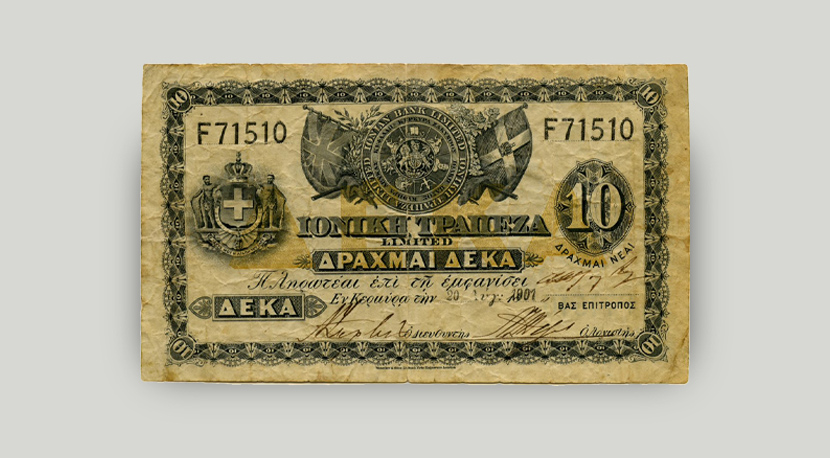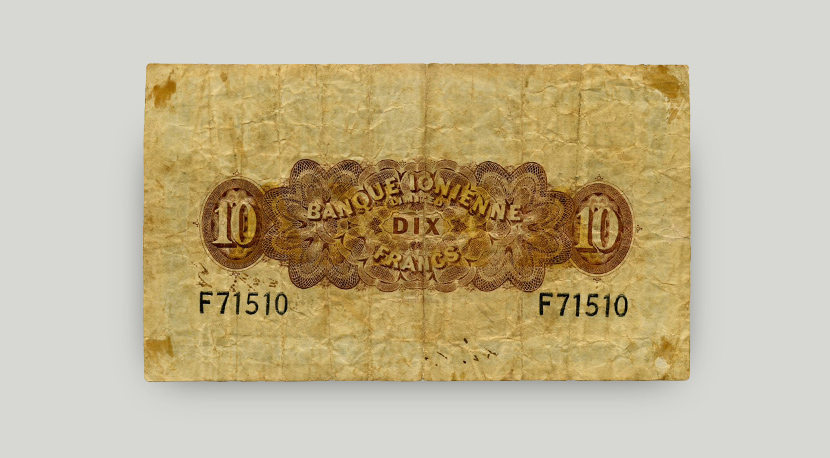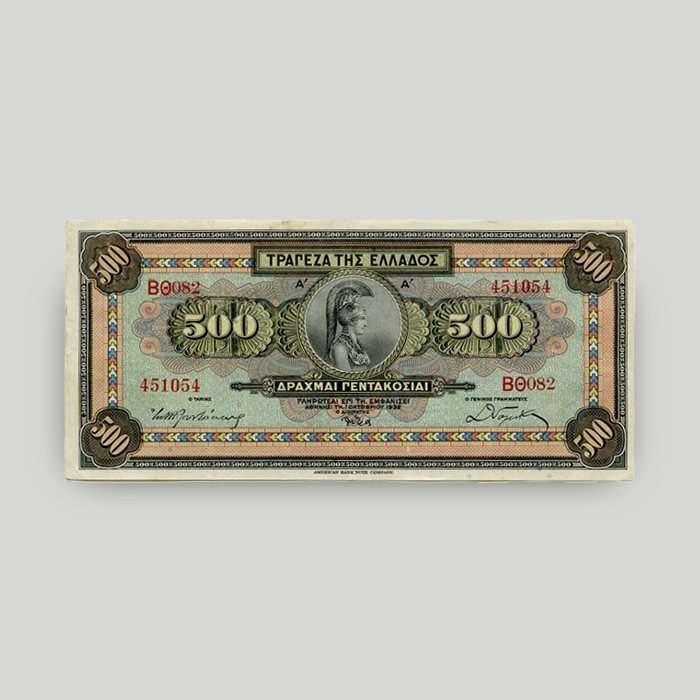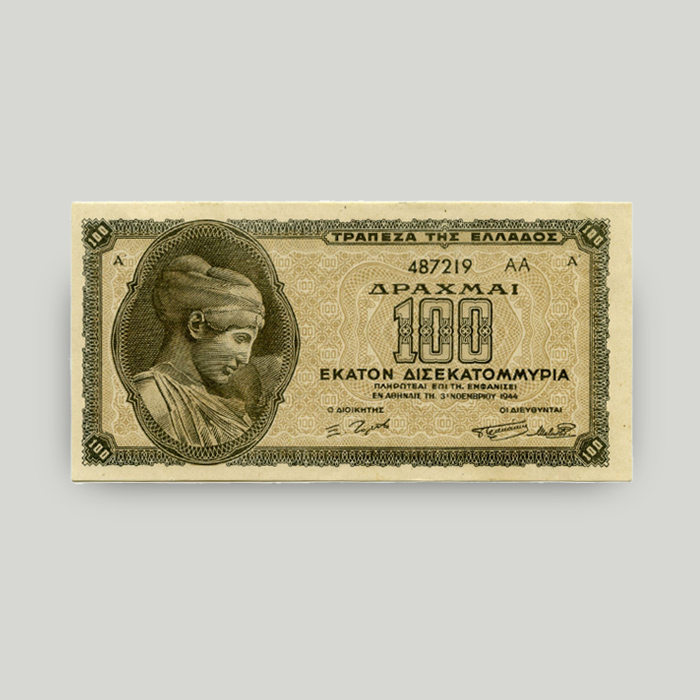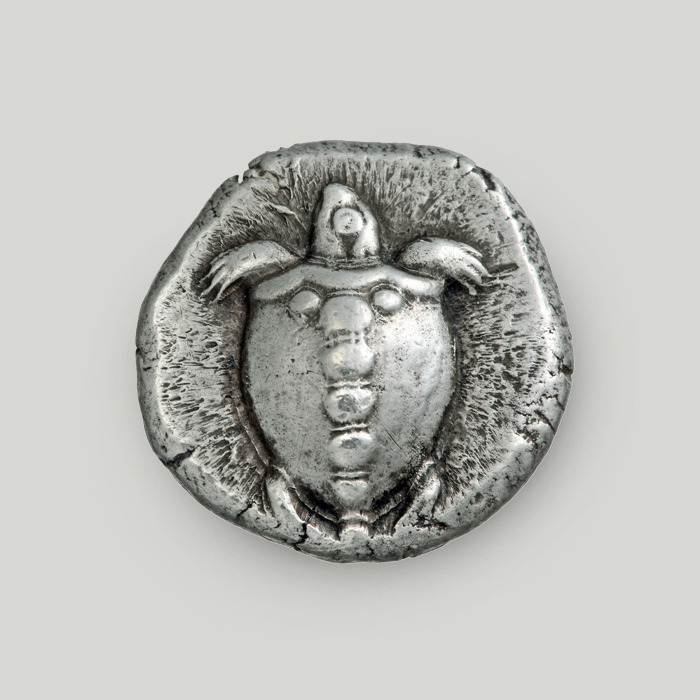10-new-drachma banknote, 1901
The 10-new-drachma note of 1901 was issued by the Ionian Bank. On 23 October 1839, a resolution passed by the Most Illustrious Senate of the United States of the Ionian Islands established the Ionian Bank in London. The bank had the exclusive right to issue banknotes for the Ionian Islands. Upon the issue of this 10-drachma banknote, Greece joined the Latin Monetary Union (LMU).
Face
Left: coat of arms of King George. Centre: the Ionian Bank logo listing all 7 Ionian Islands in Greek. Banknote identifiers are printed all over the face.
The banknote also bears signatures by the Royal Commissioner and the Bank’s Director and Accountant. The printing company name “Waterlow & Sons Ltd Banknote Engravers, London” is printed at the bottom outside the decorative border.
Back
Decorative design with the banknote denomination printed on both ends. At the centre of the design, there is the denomination in words and the bank name, both in French (DIX FRANCS and BANQUE IONIENNE, respectively).
The financials of the Ionian Islands
From 1815, the Ionian Islands were an amical protectorate of the United Kingdom. During the 1830s, their agricultural economy suffered in many ways.
In an effort to resolve its multiple problems, the British authorities suggested that a bank with currency issuing rights should be established.
A private bank in the Ionian Islands
On 23 October 1839, a resolution passed by the Most Illustrious Senate of the United States of the Ionian Islands established the privately owned Ionian Bank in London. The bank had exclusive currency issuing rights in the Ionian Islands for 20 years.
As soon as it was established, the Ionian Bank issued a trial series of banknotes in British pounds. At present, these banknotes are only mentioned in relevant reports and essays. Therefore, it is not known whether they were ever actually put in circulation.
Read more about the history of the Ionian Bank.
The first columnarios
The first Ionian Bank notes circulated in the Ionian Islands before the latter had reunited with Greece. These were banknotes in Spanish columnarios (also known as Mexican dollars or pillar dollars), a popular currency in that area.
The specific locales of circulation were printed on the banknotes. Of course, banknotes were only issued on islands where Ionian Bank branches operated.
The first drachmas in the Ionian Islands
In 1876 the Ionian Bank put in circulation the first drachma banknotes in 3 denominations: 10, 25 and 100.
These drachmas were dubbed “new drachmas”. A change in identification was required to reflect the standard adopted when Greece joined the Latin Monetary Union. The new drachmas were valued 12% higher than their older counterparts.
The banknotes of the 2nd issue (1890-1920) did not bear the clarification Δραχμαί Νέαι (Greek for “New Drachmas”) anymore. It was only printed on 10-drachma notes, which were the earliest to be issued in this context.
French in the Latin Monetary Union
The Latin Monetary Union was formed in 1865 by France, Italy, Belgium and Switzerland. Its purpose was for a single currency to be used in all member states.
Greece joined the Latin Monetary Union in 1868. However, it did not adopt the Union’s monetary system until December 1884.
When this happened, it was also decided that the banknote details printed on the back would be in French. The issue of bilingual notes aimed at making transactions easier for the people.
The banknote in our publications
The 10-new-drachma banknote of 1901 is mentioned in the book Greek Banknotes. Historical Evidence by Dr Dimitra Tsangari. The publication includes the paper money put in circulation throughout the history of the newly-established Greek state: banknotes, coin notes and other relevant material. It spans over 180 years of history. A timeline presents key moments in Greek history that were directly linked to currency circulation.
Buy the publication Greek Banknotes. Historical Evidence on the Alpha Bank e-shop.
The 10-new-drachma banknote of 1901 is on display at the Banknote Museum of the Ionian Bank in Corfu, managed by Alpha Bank.
The exhibit is open to the general public. View the Museum opening hours.
